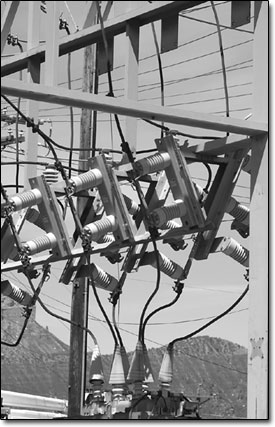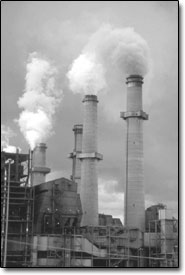|
New coal-fired plants could worsen already bad
air quality
by Will Sands
 |
Electricity flows through a
transformer near downtown Durango. Three new coal-fired power
plants have been proposed for the region to serve projected
power needs in places like Phoenix, Las Vegas and Southern
California./Photo by Todd Newcomer. |
Mercury and ozone are words that have filled headlines lately,
and they are substances that have been polluting air throughout
the Four Corners region for some time. Now there are revelations
that one of the biggest sources of local air pollution, area power
plants, could grow. Three new coal-fired power plants have been
proposed for the Four Corners region, and one of these would be
among the largest ever built in the United States.
The San Juan Generating Station and the Four Corners Power Plant,
both west of Farmington, burn coal to generate electricity for
nearly 500,000 households in New Mexico, Arizona, California and
Texas. “On any given day in the West, power is swinging
back and forth depending on what power needs are,” said
Amy Miller, spokeswoman for Public Service Company of New Mexico
(PNM). “That snapshot is constantly changing.”
PNM is the principal owner of the San Juan Generating Station
and a part-owner of the Four Corners Power Plant. The two plants
operate on sub-bituminous coal which is mined from the generous
deposits located in the vicinity of the plants. Excessive emissions
from burning this coal have created a regional problem, according
to Dan Randolph, an organizer with San Juan Citizens’ Alliance
“The two power plants that we currently have are two of
the most polluting in the United States,” he said.
Randolph noted that levels of the pollutant ozone have encroached
on federal standards in Farmington. He also commented that the
second-highest airborne mercury reading in the country was taken
at Mesa Verde National Park. The two existing plants have been
identified as major culprits in a pollution situation that’s
affecting the entire region.
Court decision could aid local air quality
Judge rules against San Juan Generating System
In
spite of the push to expand regional power generation, a recent
court decision could be good news for air quality in the Four
Corners. In late February, Federal District Court Judge Bruce
Black ruled in favor of a lawsuit brought by the Grand Canyon
Trust and the Sierra Club and against the Public Service Company
of New Mexico (PNM). PNM had tried to prevent its own monitoring
data from being used to show emission violations at the San
Juan Generating Station, but Black rejected the argument.
The
court’s ruling has opened the way for a second trial
where the number of air pollution violations at the plant
will be counted. The monitor evidence that PNM unsuccessfully
tried to keep out of court shows that the plant exceeded
its opacity limit more than 60,000 times, according to the
Grand Canyon Trust. Opacity is the density of the pollution
coming from the plant’s smokestacks.
PNM had argued that although its state-of-the-art
continuous monitors were specifically designed to measure
the density of pollution emitted by plant, violations could
only be determined by a person “eyeballing”
the plume.
Mary Wiper of the Sierra Club said that
the excesses represent not just a failure by the plant but
a failure by the current presidential administration.
“The Bush administration has failed
to enforce the Clean Air Act and hold polluters accountable
for putting New Mexicans’ health at risk,” she
said.
Rick Moore, associate director of the Grand Canyon Trust,
said that the court decision should open the door to getting
the plant cleaned up.
“This decision clears the
way for determining the number of violations at the power
plant and then moving on to establish what PNM must do to
stop violating the Clean Air Act and what penalties it should
pay for having unlawfully fouled the air of the Four Corners
region,” he said. “We are looking forward to
the next steps in getting this plant cleaned up.”
|
“It’s all the same airshed,” Randolph said.
“In Durango our prevailing wind is from the southwest, and
our air quality is increasingly becoming an urban problem, and
we are not an urban area.”
What’s even more distressing, according to Randolph, is
that the Four Corners region is on the verge of witnessing a power
plant boom. Three new power plants have been proposed in the vicinity
of Shiprock and Farmington, and one of them will be a massive
addition to the landscape.
STEAG Power, a subsidiary of a German-based power company, has
announced plans to build a major new plant near Shiprock by the
year 2008. In collaboration with the DinE9 Power Authority, STEAG
would build the coal-fired plant on Navajo Reservation land for
an estimated cost of $1.4 billion. When completed, the new plant
would be among the largest in the nation and generate enough energy
for 1.5 million homes. Numerous companies have entered into negotiations
with STEAG to buy power from the new facility. STEAG also has
signed an agreement with the developers of a planned power transmission
line that would begin in Shiprock and end in Las Vegas.
“They have also been in talking with our people, and we’re
certainly interested in any new power resources in the region,”
said Miller of PNM.
A coal-fired plant plant one-fifth this size, named the Mustang
project, is also seeking approval to begin construction between
Farmington and Grants, N.M. Originally, the plant was expected
to be operational by next year, but Randolph said there have been
some delays, and that Mustang has categorically refused to consider
alternative and more environmentally friendly technologies.
Rounding out the picture is a recent proposal for a third plant
in the vicinity4
of the Four Corners Power Plant, southwest of Farmington. On
March 22, an application was submitted for a coal-fired power
plant one-third the size of the one STEAG has proposed. Called
the Cottonwood Energy Center, the plant also would be located
on the Navajo Reservation and operate on coal from the Navajo
Mine. BHP Billiton, the company proposing the plant, would like
to have it operational by 2009.
Randolph commented that this major power plant push is the result
of several factors. “My understanding is that major new
power plant construction did not occur much at all during the
’80s and ’90s,” he said. “The companies
are now projecting future growth primarily in the Phoenix, Las
Vegas and Southern California markets.”
The reason that the Four Corners region has been targeted for
these new facilities is because of geology, Randolph added. The
facilities would all be “mine mouth” plants that would
mine generous coal deposits on site or close by, thereby cutting
transportation expenses.
“The San Juan Basin gets to wrestle with the legacy of
millions of years because of our geology,” Randolph said.
 |
The Four Corners Power Plant near
Farmington./Photo courtesy the Grand
Canyon Trust. |
And the San Juan Basin gets to wrestle with the impacts of supplying
energy for other places in the nation. “We are providing
more than our share of energy for the nation,” Randolph
said. “Before new air pollution sources are permitted, we
shouldn’t have to bear any more of the burden. The current
sources should be cleaned up significantly.”
Miller said that PNM is looking at options for making the San
Juan Generating Station a cleaner facility. However, she was less
than optimistic. “It is much harder with today’s technology
to remove mercury from sub-bituminous coal,” she said. “We’re
hoping some technology develops so we can get further removal.”
Randolph added that if new plants are constructed, they should
be state of the art and as clean-burning as possible. And he countered
that technology is available for cleaner burning coal-fired power
plants. In particular, he mentioned that San Juan Citizens’
Alliance and other groups will be pushing for Integrated Gasification
Combined Cycle technology. During this process, coal is converted
into a friendlier “synthesis gas,” thus greatly reducing
mercury and ozone emissions.
“Our geology sets us up as a sacrifice area,” he
said. “What are we going to get so that Las Vegas can use
our geology? My answer is that they should be as clean as they
can be.”
Currently, activism is largely behind the scenes on the new power
plants, according to Randolph.
“At this point, it’s slow and it’s quiet because
we want to work with the affected Navajo community before we go
out in a big way,” he said.
However, Randolph concluded by saying that a coalition of diverse
groups will be going out in a big way in coming months and years.
“The next one to five years will be critical for the Four
Corners community to decide the future of quality of air it breathes
and what it gets in exchange for exporting power,” he said.
|

